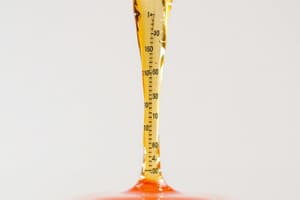Podcast
Questions and Answers
What does viscosity refer to in fluid mechanics?
What does viscosity refer to in fluid mechanics?
- The resistance of a fluid to flow (correct)
- The temperature of a fluid
- The pressure exerted by a fluid
- The density of a fluid
What is Pascal's law primarily concerned with?
What is Pascal's law primarily concerned with?
- The transmission of pressure in fluids (correct)
- The velocity of fluid flow
- The behavior of fluids at rest
- The conservation of energy in a fluid
What is the purpose of Bernoulli's theorem in fluid dynamics?
What is the purpose of Bernoulli's theorem in fluid dynamics?
- To describe the flow of heat in fluids
- To measure the viscosity of a fluid
- To determine the relationship between pressure and velocity (correct)
- To calculate the density of a fluid
If the velocity of water in section 1-1 is 5 m/s and the diameter changes from 400 mm to 200 mm, how does the velocity change?
If the velocity of water in section 1-1 is 5 m/s and the diameter changes from 400 mm to 200 mm, how does the velocity change?
What is water hammer in fluid mechanics?
What is water hammer in fluid mechanics?
Flashcards are hidden until you start studying
Study Notes
Viscosity and Newton's Law of Viscosity
- Viscosity is a fluid's resistance to flow caused by internal friction.
- Newton's law of viscosity states that the shear stress between fluid layers is directly proportional to the velocity gradient between those layers, expressed as τ = μ dv/dy, where τ is shear stress, μ is dynamic viscosity, dv is the change in velocity, and dy is the change in distance perpendicular to the flow.
Pascal's Law
- Pascal's law states that pressure applied to an enclosed fluid transmits equally to all points within the fluid and to the walls of the container.
- Applications of Pascal's law include hydraulic systems, such as hydraulic jacks, brakes, and lifts, where pressure is amplified to produce force.
Differential Manometer
- A differential manometer measures the pressure difference between two points in a fluid-filled system.
- The pressure difference is calculated by considering the difference in liquid levels in the manometer and the specific gravity of the fluid used.
- In this example, the pressure difference in terms of the head of water is calculated using the difference in mercury levels, the specific gravity of the oil, and the density of water.
Discharge Through a Pipe
- Discharge is the volume of fluid flowing through a pipe per unit time.
- The equation for finding discharge is Q = A*v, where Q is discharge, A is the cross-sectional area of the pipe, and v is the velocity of the fluid.
- In this case, the discharge is first calculated at section 1-1, then applying the principle of continuity, the discharge at section 2-2 is the same since the flow is incompressible.
Bernoulli's Theorem
- Bernoulli's theorem states that the total mechanical energy of a fluid flowing in a steady, incompressible flow remains constant along the streamline.
- The expression for Bernoulli's equation is defined as: P/ρ + V^2/2 + gh = constant, where P is pressure, ρ is density, V is velocity, g is acceleration due to gravity, and h is height.
- Assumptions of Bernoulli's equation include: steady flow, incompressible fluid, non-viscous fluid, and frictionless flow.
Notches and Weirs
- Notches and weirs are structures used to measure the flow rate of fluids.
- A notch is a rectangular opening in a vertical wall, while a weir is a structure with a sharp crest, extending across the entire width of the channel.
- Both notches and weirs work by creating a level difference between the upstream and downstream sides of the structure, leading to a predictable flow rate based on the head difference.
Discharge Through a Rectangular Notch
- Discharge through a rectangular notch is calculated using the formula Q = C1bh^(3/2)√(2g), where Q is discharge, C1 is discharge coefficient, b is crest width, and h is the depth of water above the crest.
- The discharge coefficient (C1) considers imperfections in the notch and flow conditions.
Water Hammer
- Water hammer occurs when the flow of water in a pipe is suddenly stopped or changed, creating a pressure surge due to the inertia of the water.
- The circumferential hoop stress in a pipe is the stress that acts on a circular cross-section due to internal pressure and is calculated using the formula σ=pD/2t, where σ is hoop stress, p is internal pressure, D is the diameter of the pipe, and t is wall thickness.
Additional Questions
- The text provides the following questions:
- Question 9: Not specified.
- Question 10: Not specified.
- Question 11: Not specified.
- Question 12: Not specified.
- Question 13: Not specified.
- Question 14: Not specified.
- Question 15: Not specified.
Studying That Suits You
Use AI to generate personalized quizzes and flashcards to suit your learning preferences.



